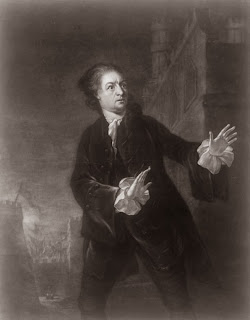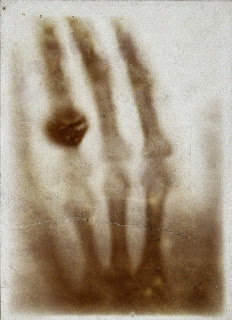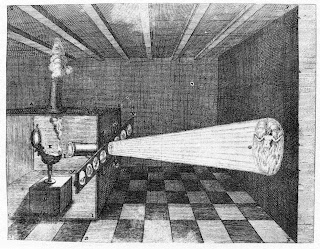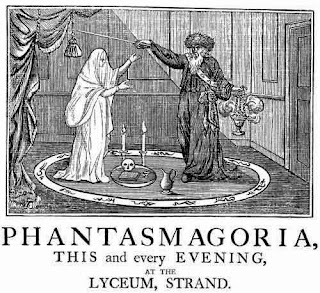The actor David Garrick had a set-piece during his performances of Hamlet, the role for which he was most famous, that electrified London theatre audiences in the eighteenth century. It came when the ghost enters at the start of the play. According to the St. James Chronicle in 1772, “As no Writer in any Age penned a Ghost like Shakespeare, so, in our Time, no Actor ever saw a Ghost like Garrick.” The German scientist Georg Christoph Lichtenberg wrote that “His whole demeanour is so expressive of terror that it made my flesh creep even before he began to speak.”
Garrick is shown in the midst of this tour-de-force in a contemporaneous print (Figure 1). Doesn’t it seem here as if his hair is actually rising from his scalp? And in fact, it really is. But not even Garrick could raise his hair at will. He achieved the spine-tingling effect (which goes by the splendid name of horripilation) with the aid of a London wig-maker named Perkins, who created a mechanical wig powered by hydraulics.

Figure 1 David Garrick as Hamlet, on seeing his father’s ghost in Act I. Mezzotint after a painting by Benjamin Wilson, 1756.
This wasn’t just a cheap trick. Garrick’s approach to what was then seen as naturalistic performance was informed by a Cartesian view of human physiology, in which the body was regarded as a kind of hydraulic mechanism driven by fluids called animal spirits that were pumped around the organs and limbs. Within this view, an artificial hydraulic wig was little different from the way real horripilation was thought to work by a rush of fluids to the head. Like all emotion, it was simply a matter of biomechanics.
But there is another defence of Garrick’s potentially absurd ‘fright wig’: he needed all the help he could get, because he’d set himself the task of conjuring the illusion of the ghost by gesture alone. Whereas previously the dead king was generally played by an actor, Garrick insisted that he should be invisible: a disembodied voice whose presence was seen only by the actors. But theatrical invisibility is a difficult trick – as film makers later discovered, it needs visible signifiers to sustain the illusion.
Garrick’s choice represented a decision not just about staging but about what the ghost in Hamlet – on which the plot of course turns – truly means. It is a statement about how the entire play should be interpreted. Because we’re then forced to ask: is this a real spirit, or just a figment of Hamlet’s tortured mind?
Partly this is a question about the significance of ghosts in Shakespeare’s time. But I want to locate this issue of the visibility of his ghosts within a wider debate about appearance, illusion and spectacle in theatre. Because it is my contention that, from the eighteenth to the early twentieth centuries in particular, science – and particularly optical science – became strongly linked to theatre, stage magic and the advent of cinema, in ways that were as much thematic as they were instrumental.
Ghosts were a common, even clichéd sight on the Elizabethan stage. They served as narrators, popping up to fill in a bit of back-story. As such, they were no cause for alarm in either implication or appearance, being represented by a sort of Jack-in-the-box puppet, or else by an actor with whitened face, dressed in clothes made of furry leather. They were a device borrowed from the plays of Seneca, which supplied a model for the revival of tragedy during the Renaissance. The Senecan ghost typically appeared in the prologue, calling for an act of revenge that motivated the play’s tragic plot.
But the ghost in Hamlet is no glove puppet. He’s made to sound hardly less terrible to the audience than he is to Hamlet and his friends: the sight “harrows me with fear and wonder”, gasps Horatio. That’s what Shakespeare did to the theatrical ghost: he made it real, humanized, haunting and disquieting. His spirits are really spooky, and in some ways they represent a supernatural stage presence that has never been equalled.
The Senecan ghost is merely a “bit of dramatic machinery”. But ghosts in Shakespeare, and in some of the Jacobean plays that came after, leave the audience guessing. Indeed, they leave the characters guessing: what sort of apparition is this? This is a question about what ghosts meant in the popular superstition of the time. The answer wasn’t simple, but we can at least say that it was determined largely by your religion. Catholics believed that the souls of the dead reside for a time in Purgatory before being admitted (if they warrant it) to heaven. This gave souls a period in which to haunt the living. But Protestants rejected the idea of Purgatory – which makes it puzzling how a dead soul can feature in what is undoubtedly a Protestant play. Might, then, the ghost be a demon masquerading as the king, to provoke Hamlet into acts of slaughter and, indirectly, Ophelia into sinful suicide?
This was the choice, it seems: ghosts were either dead souls, or they were demons – or maybe angels. All were real entities; as the Shakespeare scholar Robert Hunter West has said, when these plays were first performed “Englishmen were seriously aware in a way that we are not of an invisible world about them.” Around this time there was a vigorous debate about the meaning and status of ghosts, and several learned books were published that attempted to provide them with a taxonomy.
One of the most influential was by the theologian Noel Taillepied, called A Treatise of Ghosts. Taillepied claimed that the souls of the departed may be returned to earth by God to deliver a message. Shakespearian ghosts indeed do always have motives and messages to impart, and sometimes only the intended recipients can see them, or at least hear them. The notion of a ghost who, like Banquo in Macbeth, haunts the guilty party alone was well established in folk tradition. If we are inclined to attribute this now to the fevered imaginings of a guilty conscience, we shouldn’t imagine that Shakespeare was in contrast blindly literal – the powers of invocation and agency attributed to the imagination in the late Renaissance leave no clear distinction between a ghost being a projection of the mind and an objective phenomenon.
Ghosts didn’t, as one might expect, go out of fashion with the alleged rationalism of the Enlightenment. Certainly in popular superstition they remained as present as ever, as the famous Cock Lane Ghost of London in the mid-eighteenth century attested. That case ended in a prosecution for fraud, after investigation by a committee that included Samuel Johnson. But Johnson himself remained a firm believer in ghosts, even if not in this particular one.
What changes in our perceptions of the spirit world is not the question of whether it exists but of what it means. In the nineteenth century, the rise of spiritualism saw ghosts become sources not so much of terror as of consolation: mediums offered the opportunity to speak with the souls of the departed loved ones. And what is most striking in this period, certainly for the purposes of this meeting, is how ideas about invisible beings and unseen spirit worlds co-evolve with the development of science and technology, and also with the traditions of the theatre.
For one thing, spiritualist séances were undoubtedly pieces of theatre in themselves, designed to astonish and confound their audiences and prepared with a great deal of stagecraft (Figure 2). Here is an account by William Crookes, one of the many scientists who tried to subject spiritualism to scientific investigation, of a séance conducted in 1871 by the famous medium Douglas Home:
"At first we had rough manifestations, chairs knocked about, the table floated 6 inches from the ground and then dashed down, loud and unpleasant noises bawling in our ears and altogether phenomena of a low class. After a time it was suggested that we should sing, and as the only thing known to all the company, we struck up ‘For he’s a jolly good fellow’. The chairs, tables and things on it kept up a sort of anvil accompaniment to this. After that D. D. Home gave us a solo – rather a sacred piece – and almost before a dozen words were uttered Mr Herne was carried right up, floated across the table and dropped with a crash of pictures and ornaments at the other end of the room. My brother Walter, who was holding one hand, stuck to him as long as he could, but he says Herne was dragged out of his hand as he went across the table."
The group was subsequently treated to accordions playing themselves, floating lights, books dashed about and disembodied hands stroking their faces. The effect must surely have been overwhelming – both exciting and frightening, and doubtless calculated to inhibit objective assessment.

Figure 2 Victorian séances involved many strange goings-on that relied on carefully prepared and executed illusionistic trickery.
And as Crookes’ case shows, many scientists were taken in by all this – not simply because they were credulous, but because they surely wanted to believe. And also because some of them felt that they had more reason than ever to do so. The invention of the telegraph in the 1830s and 40s showed that it was possible to send messages instantly over immense distances, even spanning the Atlantic once the cables had been laid in the 1860s. With the appearance of the telephone a decade later, it became possible to hear voices directly over such a distance. And in the 1890s, the development of radio broadcasting by Marconi and Oliver Lodge meant that these signals didn’t even need a wire to convey them – they could be sent through the invisible ether. Many scientists figured that, if it was possible to hear the voice of someone who wasn’t physically present, it was not so hard to imagine that one might also hear the voices of those who were not even alive. Spiritualism was even sometimes called celestial telegraphy, and wireless broadcasting led people to suspect that the ether was a vast, invisible sea filled with all manner of voices, coming from who knew where. Rudyard Kipling made this analogy in his 1902 short story “Wireless”, in which some early radio hams pick up random messages from ships offshore while in the same building a man feverish from consumption acts as a human receiver for snatches of poetry by Keats that he picks up from some unknown and perhaps long dead source.
These speculations got another boost from the discovery of X-rays in 1895 (Figure 3) – an invisible form of radiation like light, but of a shorter wavelength. Perhaps thoughts might be transferred from person to person, or from the dead to the living, by similar invisible rays sent through the ether?

Figure 3 The X-ray image taken by Wilhelm Röntgen of his wife’s hand, c.1895.
And as this image shows, the technology of photography, devised in the 1830s, could make these invisible rays visible – this is the rather spooky image taken by the discoverer of X-rays, Wilhelm Rontgen, of his wife’s hand, and when she saw it she is said to have exclaimed “I have seen my death!” From its earliest days, photography seemed to be as much about revealing the invisible as documenting the visible. Because the surface of glass plates used to hold the emulsion could preserve faint images of an earlier exposure, some early photographers found that ghostly figures sometimes appeared in their images when the plates were reused. It was soon decided that these were spirits, and ghost photography because a lucrative business in the late nineteenth century. One of the first entrepreneurs of this business was an American named William Mumler, who set up a ‘spirit photography’ business in Boston and New York (Figure 4).

Figure 4 Abraham Lincoln’s shade consoling his widow, in a “spirit photograph” taken by William Mumler. The Lincolns were enthusiasts of Spiritualism, and were said to have conducted séances in the White House.
Even when scientists explained how such double exposures were easy to fake, it did little to diminish the popularity of the genre, for in its mysterious ability to capture the instant and to solidify intangible light photography seemed virtually a supernatural medium itself. Didn’t it, after all, convey a weird kind of immortality – and paradoxically, by doing so, remind the sitter that death awaits us all?
It’s quite natural that one of the first uses of photography would be to make invisible beings visible. For optical technology has always been closely allied with magic, and also with the theatre. It was long thought capable of revealing what went otherwise unseen, particularly spirits, souls and demons. The camera obscura, the forerunner of the photographic camera, in which natural scenes are projected through a small opening into a darkened space (Figure 5), was known since at least the eleventh century, and was popularized in the sixteenth century manual of natural magic by the Italian Giambattista della Porta (who was also a popular dramatist). By the early seventeenth century mountebanks were using such devices to astonish audiences.

Figure 5 The camera obscura, as depicted in Athanasius Kircher’s Great Art of Light and Shadow (1646).
Looking-glasses that produce figures “at a distance in the air” also featured in the magic lantern, an early form of projector that became a stalwart device of optical natural magic. It was described by the Jesuit inventor and mystical philosopher Athanasius Kircher in 1646: light is passed through an image painted onto glass and then through a lens before falling onto a screen (Figure 6). By the time Kircher was writing, magic lanterns were becoming commercialized. The Danish mathematician Thomas Walgensten traveled across Europe selling these lanterns and using them purportedly to summon ghosts.

Figure 6 The magic lantern, as shown by Kircher.
The magical stage spectacles of the late eighteenth century straddled this ambiguous boundary. The German illusionist Johann Georg Schröpfer held séances in his Leipzig coffee shop in which he used the magic lantern, projected onto smoke, to summon ghosts. Schröpfer’s performances were perhaps the first ‘entertainment séances’, and his techniques were copied by the German Paul Philidor, whose popular public displays in the early 1790s were unashamedly eye-catching and became known as “phantasmagoria” (Figure 7). Subsequently, Étienne Gaspard Robertson used magic-lantern back-projection in his “Fantascope” shows, in which, by mounting the device on wheels, he could make the projection grow rapidly larger or smaller so that ghouls and demons might seem to rush upon the terrified audience.

Figure 7 An advertising bill for the Phantasmagoria show of Paul Philidor in 1801.
Robertson explicit sought to scare his public with visions of ghosts and devils (Figure 8): he was in effect producing the first horror films. He was in fact a professor of physics with a special interest in optics, who realised the commercial potential of optical trickery when he attended one of Philidor’s extravaganzas. And although he made no pretence of possessing magical abilities, he exploited his specialist knowledge while artfully keeping his audiences guessing about what they were seeing.

Figure 8 The light show of Étienne Gaspard Robertson amazes and terrifies an audience in the early nineteenth century.
The most famous illusionistic ghost of the stage also comes from this collusion of science demonstration and pure theatre. In the mid-nineteenth century, the Royal Polytechnic Institute in London put on magic and séance shows to show how paranormal activities could be faked. One of the lecturers was the chemist and science popularizer John Henry Pepper, who later set up his own “Theatre of Popular Science and Entertainment” at the Egyptian Hall in London. Pepper collaborated with the engineer Henry Dircks in the late 1850s to create a technique for projecting the reflection of a hidden actor onto a huge, slanted sheet of glass: a semi-transparent apparition perfect for depicting ghosts (Figure 9). Plays featuring ‘Pepper’s ghost’, including Hamlet, Macbeth and A Christmas Carol, became sensations throughout Europe and the US.

Figure 9 Pepper’s ghost.
The Egyptian Hall was the centre of theatrical magic and scientific illusion in the nineteenth century. Perhaps the most famous residency was that of John Nevil Maskelyne, a watchmaker who began the foremost dynasty of British stage magicians (and who was, incidentally, the inventor of the pay toilet) (Figure 10). In 1905 Maskelyne and a group of other British magicians founded the Magic Circle, dedicated to the art of stage magic and illusion. Like many of these stage magicians, Maskelyne was also a debunker of spiritualists and mystics claiming special powers.

Figure 10 A playbill for the illusion and magic show of John Nevil Maskelyne in the late nineteenth century.
This role of illusionism is clear from Albert Allis Hopkins’ now classic 1898 manual of magic, in which the American amateur magician Henry Ridgely Evans proclaimed that “Science has laughed away sorcery, witchcraft, and necromancy.” Hopkins shows how stage magicians of the Victorian era made avid use of the newest scientific discoveries. He said that X-rays, discovered only two years before the book was published, “are now competing with the most noted mediums in the domain of the marvellous.” Hopkins describes a trick in which a man dining alone is suddenly cast into darkness, whereupon he vanishes and the audience sees, seated across the table, a glowing skeleton, lit up by a hidden X-ray generator (Figure 11).

Figure 11 A glowing, macabre dinner guest is conjured up using X-rays (from the generator on the right) to stimulate luminescence from a skeleton painted in a phosphorescent material, as depicted in Albert Hopkins’ 1898 book of stage magic.
The elaborate illusionism of the theatrical light-show found a new home in the early days of cinematography. In the late 1880s Thomas Edison began to create a kind of electrical magic lantern called the Kinetoscope that projected a series of still images in rapid succession to create the illusion of movement. In 1894 he opened a Kinetoscope parlour in New York, where for a few cents one could watch the first motion pictures, each lasting a minute or so. Meanwhile, the Lumière brothers turned the magic lantern into a portable, manually operated movie projector called the Cinématographe that threw the image onto a screen. A Parisian audience watched the first public screening in 1895.
In the audience for that premiere was the Frenchman George Méliès, who had developed his own form of illusionistic magic at the Paris theatre he owned. He promptly bought a movie camera and started making films himself. Many of these used his existing stage tricks, supplemented by the new illusionistic possibilities that cinematography offered. He made 78 films in 1896 alone, and over 500 during the next two decades. Several of them were ghost films, sometimes aimed more at slapstick than chills (Figure 12).

Figure 12 A scene from George Méliès’ comedy The Apparition, or Mr Jones’ Experience with a Ghost (1903).
Given this genealogy of cinema, it is no surprise that marvels soon took over. Films of ghostly and supernatural phenomena weren’t simply an early genre of cinema – they were its natural subject, for the motion picture should properly be seen not so much as “celluloid theatre” but as celluloid magic. Jacques Derrida seemed to discern this when in 1982 he called cinema “the art of ghosts, a battle of phantoms.”
What ought we to conclude from all of this?
First, that the first marriage of science and theatre happened in the arena of the magical and the illusory, and in particular in the disputed area where science and folk belief have vied for authority over the invisible.
Second, that science and technology have long had a performative aspect that was particularly prominent in the late eighteenth and the nineteenth centuries, and which involved a delicate interplay between explanation, mystification and spectacle, of the kind that I sense still persists in the Royal Institution Christmas Lectures.
Third, cinema should perhaps be a stronger part of this discourse, in the sense that its relationship to theatre, particularly in terms of its genesis, becomes much clearer once we acknowledge the close associations with optical technologies and illusionism.
And finally, I think, we should be reminded here of the role of imagination, which, both in science and in theatre, is needed to span the gulf of what isn’t known or cannot be expressed. Imagination is rarely spoken of today in science, but in a famous 1870 essay “Scientific Use of the Imagination”, John Tyndall argued that via the imagination “we can lighten the darkness which surrounds the world of our senses.” It is in its capacity to permit and depict imaginative leaps that theatre can help to illuminate and perhaps even extend some of the meanings of science.
1 comment:
This look very interesting ... will re-read with a little more consideration for the thought that went into it... meanwhile very grateful.. will reference it in an Art Foundation course media brief.
Many Thanks for posting,
Mark
Post a Comment